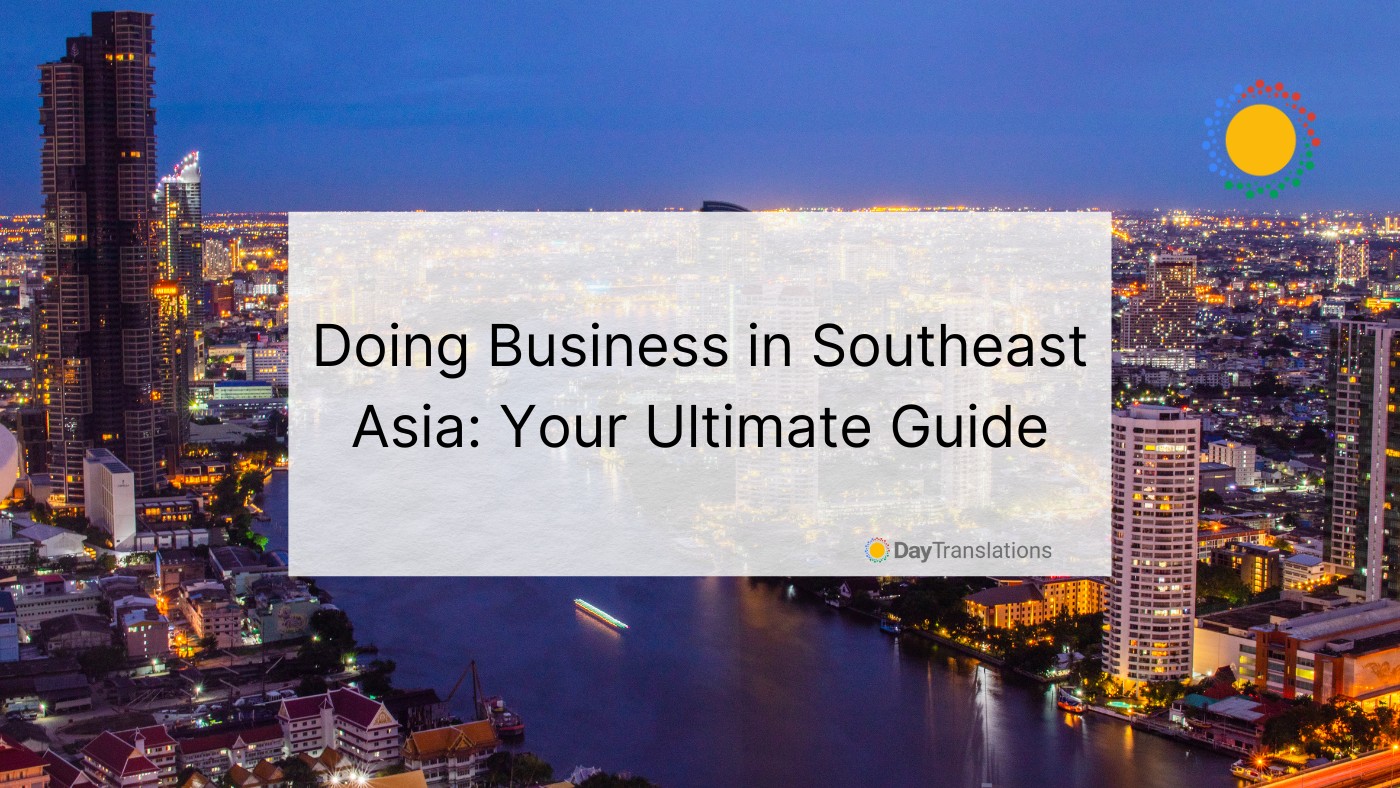Southeast Asia is a tropical region in the Asian continent. Several countries in the region are pushing the economic growth of the world, encouraging Western companies to try doing business in Southeast Asia.
Many developed countries worldwide are keen to do business in the Southeast Asian region because it presents several business opportunities that are still untapped. Most of the developing nations in Southeast Asia are members of the ASEAN or the Association of Southeast Asian Nations. As a single community, the member states present investors with various opportunities to have high returns for their investments.
It is critical for business investors from North America and Europe to know and understand the prerequisites, regulations and the laws of each country before they start their business in the region.
Geographically speaking, Southeast Asia is divided into two groups, Maritime Southeast Asia and Mainland Southeast Asia. In the first group are Brunei, East Malaysia, East Timor, Indonesia, the Philippines and Singapore. Cambodia, Myanmar or Burma, Laos, Thailand, Peninsular Malaysia and Vietnam are in the second group. Politically, there are 11 states, as East Malaysia and Peninsular Malaysia are grouped as one. Out of the 11, only East Timor (Timor-Leste) is not a member of the ASEAN.
For business investors, this means that they must contend with ten countries with:
· 10 currencies
· 10 different legal systems
· Varied religious beliefs, traditions and customs
· Different levels of infrastructure
· Various official languages, such as Burmese, Filipino, Khmer, Lao, Malaysian, Malay, Indonesian, Mandarin, Portuguese, Tamil, Thai and Vietnamese
Knowing the Emerging Markets in Southeast Asia
If you are planning on doing business in Southeast Asia, it is vital to know the different emerging countries in the region to gauge the country’s suitability to your products or services.
For clarity, discussing the Southeast Asian region typically involves the 10 member states of the ASEAN, namely Brunei, Indonesia, Malaysia, Singapore, Philippines, Thailand, Vietnam, Laos, Myanmar and Cambodia. Six of these countries are the biggest economies in the region by nominal GDP:
1. Indonesia
2. Thailand
3. Philippines
4. Singapore
5. Malaysia
6. Vietnam
Unique Markets
Companies from developed countries should remember to treat each country as a distinct and unique market. Each country presents a set of challenges, from setting up a business to accessing credit, securing construction permits, to tackling taxation laws and navigating the procedures for property registration.
Southeast Asia is the most significant emerging economy in the world today. Therefore, multinationals and investors are focusing on the region. They see the massive potential from the continuously increasing spending power of the middle class and the gigantic combined population of Southeast Asia, which is about 663.2 million (2019). Add to the mix the rise in urbanization and the improvements in telecommunications.
So many business opportunities are present in the region. However, companies that are doing business in Southeast Asia should also prepare to break through the likely hurdles that create barriers for business expansion.
The ASEAN is aiming to create a single economic community through collaboration among the member nations. The organization wants to become a single market and production base. However, many are skeptical that the formation of a single market can be successful since many differences exist between the member nations. The rules for foreign investments vary. The economic terms, political agenda and the way each country does business across other markets are significantly different.
The situation is not that same as in Western Europe and Latin America were investors can group countries into larger markets due to similar culture and language. That is not easy to do in Southeast Asia.
For example, Singapore is a small market, but it has a stable currency, stable government and excellent infrastructure. On the other hand, Indonesia has a huge population. It has a $2 trillion economy, but its foundation is still limited. Myanmar is the poorest ASEAN member country, but its mobile markets are the fastest-growing markets in the world. It’s difficult to believe that 75% of the population in Myanmar is without electricity.
Factors to Consider When Doing Business in Southeast Asia
For companies that are used to the straightforward legal and business environment in other areas such as the United States, the UK, Australia and Singapore, doing business in Southeast Asia is going to be an eye-opener.
1. Restrictions and regulations
The situation is quite complicated as they have to deal with differing regional and local laws, intellectual property registration, brand protection and immigration policies. There would be a risk of corruption and bribery.
Many of the markets in the ASEAN, such as Cambodia, Vietnam and the Philippines have restrictions on FDI (foreign direct investment). They require international firms to have local partners as well as local shareholders. Some countries require foreign companies to undergo prior screening and approval before they can begin operation. ASEAN member countries except for Singapore, have various restrictions when it comes to FDI compared to the countries that belong to the Organization for Economic Cooperation and Development (OECD). But the limits also depend on the business sector you are interested in. More regulations are imposed on banking, transport, fisheries and telecoms.
You are also likely to encounter trade sanctions. For example, the U.S. still continues to impose trade sanctions on Myanmar.
2. Recruitment Difficulties
One of the objectives of the economic community of the ASEAN is to have a free flow of skilled labor across the region. However, this is still in the proposal stage. The region’s markets still follow their regulations, often vague and strict, when it comes to employing other workers, even from neighboring countries. Therefore, it is essential to check
whether it is possible to relocate some of your staff or you can hire foreign workers to work in-country.
3. Different Timescales
Western companies are quite strict with project deadlines. However, this concept is not commonly adhered to in the East. You have to adjust your schedule if you want to manage your timeline, especially in these areas:
· Immigration
· Import licenses
· Business licenses documentation
· Governmental and legal rules that can change without prior notice
· Negotiation and conclusion of contracts with suppliers
· Processing redundancies at work
4. Building trust
Personal friendships and trust are vital to people in the East. Thus, you need to make frequent trips to the country you want to enter. You need to conduct several face-to-face meetings before you can secure a firm commitment. This is one of the reasons why you have to change your timelines when you’re thinking of doing business in Southeast Asia. You cannot force the decision-makers to hurry. They have their own rules and for you to get that all-important approval to do business in the country, you should have plenty of patience.
It is not only your prospective business partners that you should understand. It is critical to have first-hand knowledge of your potential customers, partners and suppliers. As much as possible, talk to people who are living and working in the target country for some time. Their insights would be valuable information as you continue the business proceedings.
5. Cultural sensitivity
Keep in mind that cultures in the East are different from the cultures in the West. Displaying consideration is quite significant when doing business in Southeast Asia. ”Saving face” is vital to the regions’ population. It is necessary to avoid situations or actions that could cause discomfort or embarrassment to other people. For example, you should not reject the appropriate gifts given to you or refuse the hospitality your business counterparts offer during meals. Moreover, avoid playing the blame game in public if you want your business deal to proceed.
6. Understanding the various challenges
Be prepared for the many challenges you are likely to face when doing business in Southeast Asia. Leveraging approaches such as data driven recruiting can mitigate workforce-related difficulties and enhance operational efficiency. If you are impatient, you’ll end up frustrated, especially if you did not do your homework to understand the business environment and the culture of your target country. Here are some of the things you are likely to encounter.
· Economic disparity, since some of the nations are more progressive than others
· Government assistance for international businesses – it varies depending on the country. Some make it easier for investors to establish their businesses in their country while others still have bureaucratic practices that prolong the process of starting a business.
You have to remember that each country’s processes are different, so your assumptions for one country would not be applicable to the next target country. It’s to your advantage to have street knowledge about each country you want to do business with by hiring local consultants to augment your advance team’s work.
General Business Etiquette
Practicing business etiquette is vital when dealing with business colleagues wherever you go. People in Southeast Asia are more sensitive compared to the rest of the world and each country has its own set of business etiquette. We have already covered the need for more return trips to build trust and nurture personal friendships as well as being more culturally understanding.
Another thing you have to learn is how to correctly use your business cards. In the East, it is considered as an extension of the person who is giving it, so it should be respectfully presented and received. Use both hands when presenting and receiving a business card. Read the card carefully and do not put it inside your wallet, pocket or anywhere else. During the entire meeting, it should be on the table, close to the business papers you have with you. The details on your card should be translated into the local language and printed on the reverse side of the card. Ensure that the local translation is shown when presenting your cards. Likewise, see to it that you bring a stack of them with you as it is very likely for you to meet more people than expected.
Punctuality is important. Arriving late for social events is normal for most Asians, but it does not apply to business meetings.
In countries where Muslim and Hindu cultures are dominant, such as in Malaysia and Singapore, be sure to use only your right hand when you are doing social interactions
such as when giving and receiving gifts. Beware of body gestures, particularly pointing with your right hand. It is better to point with your knuckles or extend you right hand with the palm down to point to something instead of using just one finger.
Avoid touching a person’s head when you are in a country where the people dominantly follow Hinduism and Buddhism.
In most countries in Southeast Asia, you are required to dress moderately for business meetings. In Singapore, however, it is better to dress smartly.
Doing business in Southeast Asia is a learning experience because you will find that the business culture in the region is very different from what you’re used to. See to it that you have all the right information about the business environment, protocols, language, culture and target market data analysis before you plan your first visit.
Learn Southeast Asian Culture from Us
Learning about different cultures takes time. Day Translations, Inc. offers you a rare chance to understand the different cultures through our blogs. We consider ourselves cultural experts and you can find insights to various cultures in Southeast Asia and other parts of the world through our well-researched articles. And if you need help with translations services, give us a call at 1-800-969-6853 or send us an email at Contact us. We can easily connect you to our native speaking translators who live in-country. You can reach us anytime as we are open 24/7, 365 days of the year.












Sorry, the comment form is closed at this time.